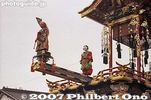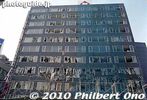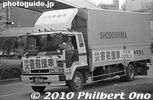 Image search results - "Sanno" Image search results - "Sanno" |

The Sanno Matsuri Festival is one of Japan's Big Three Festivals and one of Tokyo's Big Three Festivals held in mid-June during several days. The main highlight is the Jinko-sai Procession held every two years. The 600-meter long procession consists of about 500 people parading through central Tokyo near the National Diet, Imperial Palace, Tokyo Station, and Ginza. It includes three portable shrines, carriages, and flower floats. Various events are also held at Hie Shrine which holds the festival. Jinko-sai Procession left Hie Shrine at 8 am on June 11, 2004. Before noon, they approach the Imperial Palace. 山王まつり神幸祭
|
|

The Jinko-sai Procession passes in front of the Imperial Palace.
|
|

For a procession this large and grand, the crowd of spectators was extremely sparse. Good for photographers like me, but it was strange.
|
|
|

Hie Shrine's Sanno Matsuri Jinko-sai Procession in front of Imperial Palace.
|
|
|

One of the three portable shrines.
|
|

The original procession included many high floats. However, due to overhead power lines and overpasses, such floats cannot be included.
|
|
|
|

Omiko Shrine maidens
|
|

Flower float, Sanno Matsuri
|
|
|
|
|

Rest stop near Sakashita-mon Gate at the Imperial Palace.
|
|
|
|

Shrine maidens dance in front of the three portable shrines near Sakashita-mon Gate.
|
|
|
|
|
|
|

During this break period, the shrine priest and other representatives enter the Imperial Palace to pray for the peace, happiness, and prosperity of the Imperial family. Hie Shrine is the only shrine in Japan bestowed with this privilege.
|
|
|

Some entertainment.
|
|
|
|
|
|
|
|
|

The procession passes by Tatsumi Turret as it leaves the Imperial Palace.
|
|

The Takayama Festival is held twice a year, during April 14-15 and Oct. 9-10. The spring festival is held by Hieda Shrine and it is called Sanno Matsuri. The festival features twelve ornate "yatai" floats which are displayed and pulled along the streets. In a large plaza, katakuri puppets perform on a few of the floats. The festival is also dramatic at night with a float procession. The Takayama Festival procession in spring starts at Hieda Shrine. Photo shows a banner reading "Hieda Jinja." 祭行列
|
|
|

Hie Shrine hall. The shrine is on Shiroyama Hill. 日枝神社On Dec. 1, 2016 (JST), Takayama Matsuri Festival was inscribed as a UNESCO Intangible Cultural Heritage of Humanity as one of 33 "Yama, Hoko, and Yatai float festivals in Japan."
|
|
|

The portable shrine (mikoshi) passes through Hie Shrine's torii to join the procession. 神輿
|
|
|

Shrine officials in the procession.
|
|

A mikoshi passes by Tatsumi Turret of the Imperial Palace durng the Sanno Matsuri Jinko-sai.
|
|
|
|
|
|
|

Shrine maidens
|
|
|

Mikoshi
|
|
|

Shrine maidens
|
|

Road to Tokyo Station.
|
|

Shrine maidens
|
|

Crossing the street.
|
|
|
|
|
|

All the auto traffic and urban noise robbed the dignity of the solemn procession.
|
|

A middle-aged woman uses her camera phone to photograph herself. "I was here!"
|
|

Crossing the street near Maru-biru Building. They proceeded to Tokyo Station, Kyobashi, Nihonbashi, Shimbashi, and Ginza before returning to Hie Shrine at 5:30 pm.
|
|

Portable shrine 神輿
|
|

Map of Jinko-sai Route.
|
|

Portable shrine 神輿
|
|

On the next day on June 12, 2004, was Miya-iri or portable shrines entering Hie Shrine. Led by this cart of festival musicians. 山王まつり宮入り
|
|

Shrine priest
|
|
|

Large crowd gather to watch the karakuri puppets perform on the ornate floats. Sign says "Watch out for pickpockets."
|
|
|

Large crowd gather to watch the karakuri puppets perform on the ornate floats.
|
|

Children dressed as tekomai, Sanno Festival.
|
|

Only four of the 12 floats have karakuri puppets which perform. Takayama Matsuri, Gifu
|
|

Parish members reach the shrine.
|
|

The karakuri puppets first appeared on the Takayama Matsuri floats in the 18th century. They were handcrafted by artisans in Kyoto.
|
|

Parish members wait for the portable shrines to arrive. The paper lanterns are written with the names of the parish.
|
|

Japan has three basic types of karakuri puppets based on the region: Kyoto, Nagoya, and Kanto (Tokyo area). The Takayama karakuri are the Nagoya-type.
|
|
|

The puppets come out on a plank sticking out of the float and perform in a mini play with various stunts.
|
|

A mikoshi arrives at Hie Shrine.
|
|

Ryuujintai Karakuri 龍神台からくり
|
|

They pass through the ring.
|
|

Sanbasou Karakuri 三番叟からくり
|
|

In front of the shrine, the priest blesses the mikoshi portable shrine.
|
|

Sanbasou Karakuri 三番叟からくり
|
|

The portable shrines came one after another.
|
|

Ryuujintai Karakuri 龍神台からくり
|
|
|

Ryuujintai Karakuri 龍神台からくり
|
|
|

Ryuujintai Karakuri, Takayama Festival, Gifu 龍神台からくり
|
|
|

The karakuri perfom one float at a time.
|
|
|

Shakkyoutai Karakuri which transforms into a lion dance. 石橋台からくり
|
|
|

Ryuujintai Karakuri 龍神台からくり
|
|
|

Ryuujintai Karakuri throwing confetti. 龍神台からくり
|
|
|

Street lined with floats.
|
|

Quite a spectacle.
|
|

Floats are displayed on the street. Takayama Matsuri, Gifu
|
|
|
|

Hie Shrine Sanno Matsuri
|
|
|
|
|
|
|
|
|

People linger in the shrine after all the mikoshi had arrived.
|
|
|

On the next day June 13, 2004, a Daidengaku troupe performed dances. 大田楽
|
|

Superb embroidery
|
|

It was semi-traditional and semi-modern.
|
|
|
|
|
|
|
|
|
|
|
|
|
|
|
|
|
|
|

Storehouse for a float. 屋台蔵
|
|
|

Held on April 14, the night procession is the festival's major highlight. 夜まつり曳行
|
|
|

The floats are lit and paraded on the streets.
|
|
|
|
|
|
|
|

On Nakahashi Bridge.
|
|
|

The floats cross Nakahashi Bridge.
|
|

Kentosai Sacred Dance
|
|
|

Shrine maidens perform Kentosai dance
|
|

Minami Sanno Matsuri Festival is held annually on April 4 by Hieda Jinja Shrine in Okubo and Seon (大窪、清雲). 南山王の祭 Map
|
|

Minami Sanno Matsuri Festival is like a picnic under streamers called hoinobori.
|
|

The hoinobori are carried from the respective parishioners neighborhoods to this park next to the shrine.
|
|

Minami Sanno Matsuri Festival. For a few hours, they gather under the hoinobori with food and drinks.
|
|

View from Hieda Shrine.
|
|
|

Minami Sanno Matsuri Festival in Hino, Shiga.
|
|

Under a hoinobori, made of bamboo strips wrapped with paper and attached with paper flowers, usually pink.
|
|

Hoinobori paper flower.
|
|

Hieda Shrine
|
|

Since Jan. 2010 is the 15th anniversary of the Kobe earthquake that struck on Jan. 17, 1995, I decided to upload these photos for the first time. I visited Kobe 10 days after the killer quake struck. Had to take a hydrofoil from Osaka to reach Kobe.
|
|

Kobe Port. Most of the people entering Kobe during this time were relatives and friends of Kobe residents, bringing relief goods.
|
|

Distribution place for relief goods. Ten days after the earthquake, the initial fires, confusion, and pandemonium had subsided. It was pretty calm by then, but the damage was still visible.
|
|

Kobe City Hall buckled at the middle floor.
|
|

Near Kobe City Hall along Flower Road was this office building which had also collapsed at a middle floor.
|
|

Santica building near Sannomiya Station had a middle floor crushed. As I walked around the devastation, I could see common ways in which the buildings collapsed. High rise buildings commonly collapsed on a middle floor.
|
|

Kobe Shimbun newspaper offices near Sannomiya Station was in shambles.
|
|

Expressway pylon broken.
|
|

In front of Sannomiya Station is Sogo Dept. Store.
|
|

Sogo Dept. Store cracked vertically in the middle. This building was later torn down and replaced with a new dept. store building.
|
|

Cracked Sogo Dept. Store in Sannomiya.
|
|

Employees are removing merchandise from Sogo Dept. Store.
|
|

Shop shutters along Ikuta Road are tilted due to the crushing weight.
|
|
|

Tilted buildings near Sannomiya Station. It took only 15 sec. to wreak all this damage.
|
|

The building next to Washington Hotel scraped against the hotel as it fell.
|
|

Damage to Sannomiya Station building.
|
|

Sannomiya Station
|
|

Hankyu Railways' Sannomiya Station being torn down.
|
|
|

Nihon Seimei Bldg. collapsed at the middle.
|
|

Nihon Seimei Bldg. collapsed at the middle, near Sannomiya Station. It's hard to imagine what would've happened if the quake struck during working hours with people working in this building.
|
|

A mess inside a restaurant.
|
|

Fallen clock which stopped at the time of the earthquake.
|
|

No, my camera lens is not distorting this picture. That building is actually tilting a lot, but they still allowed traffic on the road below.
|
|
|

Crushed car
|
|

Store in shambles.
|
|

Interesting contrast between buildings which fell and didn't fall.
|
|
|

Amid the rubble of a collapsed building, a yakisoba stall sold yakisoba noodles.
|
|

People eating yakisoba amid the rubble.
|
|

Another common way in which buildings collapsed was the 1st floor giving way like this small hotel.
|
|

The 1st floor is totally flattened.
|
|

One hotel guest escaped by using bed sheets as a rope.
|
|
|

Backstreet destruction.
|
|
|

Sign saying they are okay.
|
|

Vending machine
|
|

Truck carrying relief goods.
|
|

Boxes of food (biscuits).
|
|

A building owner stands by her destroyed building.
|
|

Crushed car
|
|

In the Kitano area where there are many Western-style homes, the damage was not so apparent. But the interior sustained damage. None of the buildings collapsed though.
|
|

Weathercock House, built in 1909, withstood the quake.
|
|

Only the chimney broke off atop the Weathercock House. The inside is a different story.
|
|
|

Water station
|
|

Line for the bus headed for Ashiya Station.
|
|

Bus for Ashiya Station, the furthest that trains could go at the time. Trains weren't running within Kobe.
|
|

The Sanno-sai Festival is held annually on April 12-15 at Hiyoshi Taisha Shrine in Otsu, Shiga Prefecture. Not to be confused with the Sanno Matsuri held by Hie Shrine in Tokyo. It centers on April 14, the shrine's most important day called Reisai.
|
|

Hiyoshi Taisha is at the foot of Mt. Hiei (home of Enryakuji temple) and it worships the mountain god. The Sanno-sai festival is the shrine's biggest festival and one of Shiga's biggest festivals. MAP
|
|

On April 12, they raucously bring down portable shrines from Mt. Hachioji nearby in the evening. On April 13, they hold a series of ceremonies including this one called the Tea Offering Ceremony at 11 am. 献茶祭
|
|

Hiyoshi Taisha's tea field is said to be Japan's oldest. Tea picked from this field is presented to the gods housed in the portable shrines.
|
|

The Tea Offering Ceremony is held at the Yomiya-jo where the four portable shrines (mikoshi) are placed. 宵宮場 大政所
|
|

Delivering the tea.
|
|

Delivering the tea.
|
|
|
|

The tea is offered to each of the four mikoshi which had been brought down from Mt. Hachioji the night before. The tea is said to bring safe childbirths.
|
|

These photos were taken on April 13-14, 2009. I still have to see the other ceremonies.
|
|

After the Tea Offering Ceremony, they march back.
|
|

The Sanno Festival (in Japanese it's called Sanno-sai, not Sanno Matsuri) consists of a myriad of festival events. Also interesting is the participation of Buddhist priests from Enryakuji temple atop Mt. Hiei.
|
|

The four mikoshi at the Yomiya-jo storehouse.
|
|
|
|

Monkey carvings on a mikoshi. The monkey is the messenger of the mountain god.
|
|

At 1 pm on the Sando main road leading to Hiyoshi Taisha Shrine, the Flower Procession (Hana-watari-shiki) is held with little kids dressed up as nobility.
|
|

The procession includes samurai.
|
|

Flower Procession draws large crowds.
|
|

Spectators come to see their classmates in the procession.
|
|

Flower Procession on Sando 花渡り式
|
|
|

Flower Procession. They walk slowly and deliberately with parents and relatives in tow. 花渡り式
|
|
|
|
|
|
|

Flower Procession, Sanno-sai Festival. There are two escorts wearing ceremonial aprons and they drag a wand over the road.
|
|
|

Little kids in ceremonial dress for this fesival are called chigo. 稚児
|
|
|

THe Flower Procession is held to celebrate the birth of the shrine's child god. Therefore, this event centers on the parent-child connection.
|
|

Some kids get tried and end up being carried.
|
|
|

The Flower Procession ends at the Yomiya-jo where they bless the child in front of the mikoshi. This Flower Procession ceremony costs the proud, doting parents big bucks.
|
|

Family portrait with the chigo child.
|
|

Samurai warriors in the Flower Procession.
|
|
|

Hi kids!
|
|
|
|

The next ceremony is the Hitsuji Offering Ceremony conducted by parishioners from Hiyoshi Jinja Shrine in Kyoto. Starting at 3 pm on April 13, this ceremony has been conducted for many centuries since the Heian Period. 未の御供献納祭
|
|

The offerings are given to the four mikoshi at the Yomiya-jo storehouse.
|
|

Afterward, they move to Hiyoshi Taisha's Nishi Hongu Shrine.
|
|

Hiyoshi Taisha's Nishi Hongu (West) Shrine. This building is a National Treasure. 西本宮
|
|

Assistants stand on the steps of the Nishi Hongu.
|
|

The Hitsuji offerings include arrows, bells, brushes, dolls, flowers, and sweets. Priests give prayers as they deliver the offerings.
|
|

Young ceremony assistants.
|
|

April 13 climaxes in the evening with the Yomiya Otoshi Ceremony starting with a torch procession around the streets near Hiyoshi Taisha from 6 pm.
|
|

Shrine parishioners carry giant torches around the streets of Sakamoto the neighborhood of Hiyoshi Taisha.
|
|
|
|
|
|